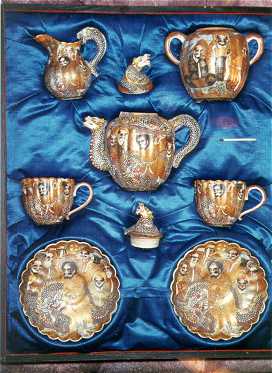
This page is only one of many thousands of Gotheborg.com Help and Information Pages, offering specialized knowledge on Chinese and Japanese Porcelain, including a Glossary, Q&A, Chinese and Japanese Porcelain Marks, Chinese Porcelain Exhibition and Excavation reports etc. For personal help and far more information, join our Discussion Board or use 'Ask a Question' for quick email consultations. For full text and better navigation, use a full-screen device rather than a mobile phone, that offers only limited content.

I have a teaset I would like you to see in hopes that you can give me some kind of information. I received this teaset almost 20 years ago and I dont know much about0. It has never been out of the box which is an original wood box with chinese silk as the lining. There are some kind of gold stamp on the bottom of each piece.
What you have is Japanese earthenware pottery of a type which is called "Satsuma".
Satsuma have been and are presently being copied both in China, Vietnam and possibly even in the west, but I see no reason to assume your pieces are "copies". Most often the marks are correct and clearly states what they are.
This Tea set is Kyoto Satsuma earthenware.
 Of the mark I can only make out the two top right characters who says "Dai Nippon" which just means "Japan".
Of the mark I can only make out the two top right characters who says "Dai Nippon" which just means "Japan".
The origins of Satsuma earthenware does go back a long time though.
The first pottery with this name was founded in the 17th century, in Kagoshima Prefecture by the Prince of Satsuma. These old pieces were different than the modern ware and were all made of brown clay. In the late 18th century clay from Kagoshima Prefecture was brought to Awata (near Kyoto) to make Satsuma type ceramics.
Most Satsuma pieces we see today are probably made at Awata from the mid 18th century to the 20th century. They are made from a clay that requires a lower temperature firing than porcelain and are of a light, yellowish earthenware with crackeled glaze and a soft finish. Besides Kyoto, Satsuma was also made in, or decorated from blanks in, Yokohama and Tokyo, and exported to the West.
Thank you for your interest.
Best regards,
Jan-Erik Nilsson